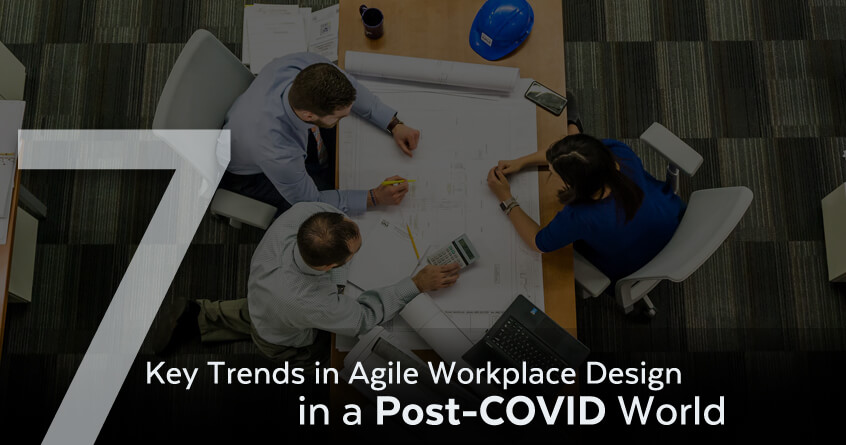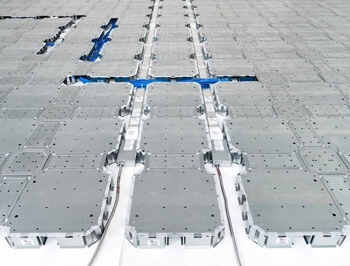If there’s a lesson to be learned from being stuck at home during COVID, and struggling to get things done at home that might have taken seconds in the office, it’s this–the agile workplace wins. Workplace agility is nothing new, but developing it has taken on a new urgency. Essential workers with the good fortune to be able to work, needed to socially distance literally overnight. The notion of workstation flexibility, once bordering on the absurd, has now proven to be essential. We’re wiser now. We realize how fragile situations can be and that agility is critical.
Why? Agility equals readiness. It allows buildings to respond to the dynamic flow of priorities of its inhabitants. It’s a two-way conversation between architecture and people, and it’s changing our understanding of what’s smart about the smart building.
This blog will explore seven qualities that embody this idea of the agile workplace and the flexibility organizations need. There are more, but we felt these were an excellent place to start the process if an organization were ready to take on this process more fully.
One: The Agile Workplace Is Sustainable
Key considerations for designing sustainability into an agile workplace are worker wellbeing, technology integration, and workflow enhancement.
Worker wellbeing leverages environmental capabilities to optimize the conditions for the mental and physical health of employees.
Technology or smart building integration uses technology tools to maximize a building’s potential to be as close as possible to energy-neutral (net zero) or energy-efficient. It’s more of a journey than a destination.
Workflow enhancement in smart, agile workspaces relies on automated controls and cross structure transparency to simplify the process of management. This is the heart of sustainability.
“Rather than designing things that can only be used once, design so they can be disassembled and used again,” says Gary Clark, chair of the Royal Institute of British Architects (RIBA) Sustainable Futures Group.
Here’s the Sustainable Futures Group list of preferable characteristics for a working environment.
- No fixed desks
- Mobile technology
- Settings promote mood and activity
- Sticky spaces for deep collaboration
- Blurring inside and outside
- Contact with wind, sun, and greenery
- Mixing eating, working and socializing
Each of these factors combines to amp up the agility of the responsiveness of a building.
Two: It Centers on the User
The workspace adapts to the inhabitants in the space providing ease of use. That means that as the needs of users flow with their business priorities, the space can quickly adapt. Areas throughout the building may differ based upon the unique ways it is used, conforming to worker specifics:
- Labs
- Meeting spaces
- Workstations
- Chillax zones
Each space uniquely conforms to the workers in that space.
Rather than using a traditional office approach, where workers have assigned desks and rooms where they work each day, designers and facilities teams model spaces on the Activity Based Working (ABW) principle. In ABW, workers choose where they work each day and even move items around their workspace to address the moment’s priorities. The emphasis is on better collaboration, efficiency, and productivity.
Three: The Agile Workplace Self-Diagnoses
The implementation of building controls and cross-platform visibility is a rapidly growing approach in building management. These platforms and apps pay for themselves in a relatively short period, saving man-hours and reducing the need for manual processes. One app that embodies this principle is Gridd® Mobile, an app used for cable management in raised floors. Designed as a tool to be implemented alongside FreeAxez’ raised access flooring system, the augmented reality app gives facility managers, IT teams, electricians and maintenance personnel the ability to see the status of the power and data cabling beneath the floor from the convenience of a tablet or a smartphone. It even allows them to access product information to help troubleshoot problems without disruption.
In an agile campus setting, machine-to-machine communication builds efficiency and eliminates steps.
Image courtesy: FreeAxez
Four: It Offers Convenient Operational Controls
Properties with intelligent lighting systems, smart HVAC, deploying a full range of PoE devices, including sensors, help conserve power, simplifying maintenance. IP addresses make device tracking easy. Managing resources, as well as the ordering and inventory, are visible on a single screen with aspects becoming automated.
Next-generation building automation systems and controls will interconnect entire building mechanical, electrical, and plumbing, combined with lighting and daylighting. Sensors and personalized controls will make easy the efficient use of power, improving management productivity.
Cloud-based and IoT-connected systems allow enterprise-wide and remote access. They automate predictive and preventive technologies like leak detection sensors and water valves shut off.
“Most discussions of smart buildings today focus on data collection and user customization,” says Paul De Santis, LEED AP, Partner with Goettsch Partners. “The data is mostly derived from enhanced sensoring, while the customization is driven through new mobile technology interfaces.”
Five: It Offers Multifunctional Spaces
A multifunctional space not only addresses the need for multiple functions within one area of a structure, but it also goes beyond. It also adapts to the larger setting, whether in a city, campus, or public space. Flexible workplace designs offer employees flexibility and adaptive accessibility for ADA compliance. Inclusivity allows employees to feel comfortable and productive.
Six: It Leverages the Modular Building Approach
Floors that can be reconfigured over a weekend, walls that move to make places bigger and vice versa—these technologies future proof and adapt allowing a workforce to evolve freely without the constraints of a building—people first then a facility. That is the right prioritization.
Seven: The Agile Workplace Collects and Analyzes Data to Improve Tenant Experiences
Behavioral data—both of people and buildings—uncovers gaps and allows decision-makers to customize the experience, remediate, and thereby boost the potential performance of both. Small corrections make a big difference in the long run.
Why Develop Workplace Agility?
“Opportunity doesn’t make appointments, you have to be ready when it arrives,” Tim Fargo, American author, keynote speaker, angel investor, and entrepreneur.
As we’ve seen with COVID, there are just some things you cannot foresee. Preparation and responsiveness have won the day for many people. Developing an agile workplace is a smart investment in the future, and it’s also a smart investment today.
Responsiveness and efficiency in taking care of your biggest asset, your people, is money well spent and that care is going to work its way out to care for your customer, and that is agility indeed.
Find out more about Versa Technology and our IT networking solutions.


